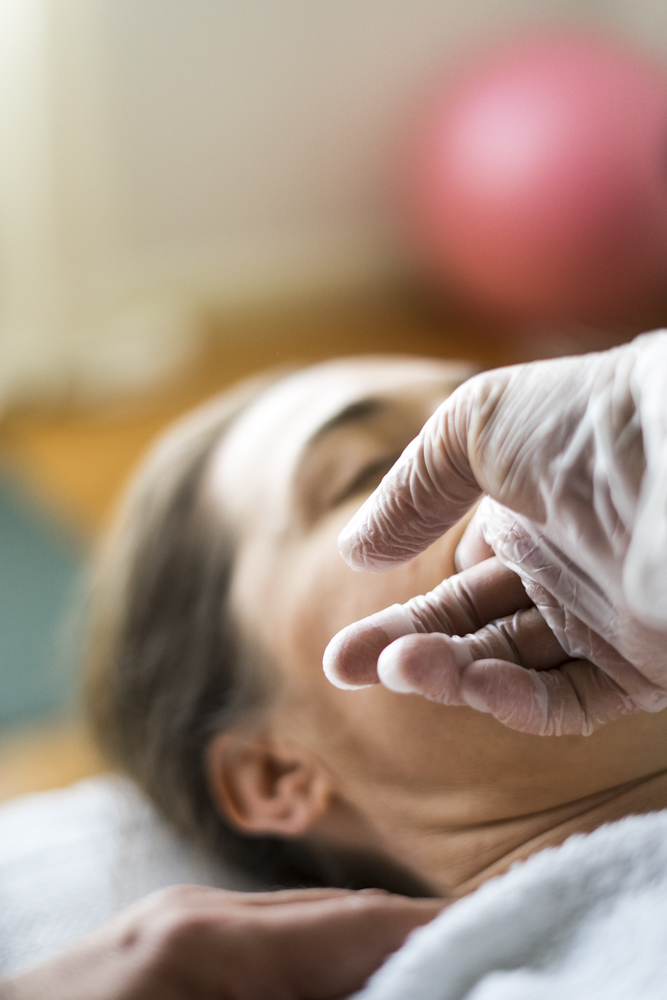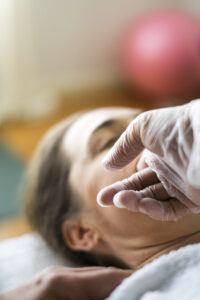
When you think of massage therapy, you think neck and shoulder pain alleviation, right? Well, there’s so much more to it than that!
You might even be shocked to learn that many Massage Therapists are trained in massaging and doing manual manipulations inside the mouth.
Umm, what? And more importantly, WHY?!
Massage Therapy for TMJ Disorder, Jaw Clenching & Tooth Grinding
Abbreviated to TMJ – the temporomandibular joint basically connects the jaw to the skull. This hinging and sliding joint is essential for chewing, yawning and so many more pivotal actions of the body – like kissing, muah!
However, it’s also one of the most troublesome joints, as millions of people worldwide reportedly suffer from a condition known as “TMJ disorder” – which is classified as chronic pain and dysfunction in the TMJ.
Nobody knows for sure what exactly causes TMJ pain, although things like teeth grinding, jaw misalignment, and facial injuries are all linked to it.
While treatment options vary, TMJ pain may go away over time while other sufferers may require painkillers, orthodontics, or even surgery to manage symptoms or correct them.
However, one increasingly popular treatment option is Intraoral/TMJ Massage.
What symptoms may be alleviated by intraoral massage?
- Clicking and/or popping of the jaw
- Toothaches due to constant clenching
- Headaches, especially upon waking
- Ringing in the ears (tinnitus)
- Lockjaw – both closed and open position
- Limited range of mouth opening
- Chronic jaw pain
When a client comes to see me complaining of the above symptoms, as a Structural Integrator & Bodyworker, my first question is always
“Are you aware of clenching or grinding your teeth at night?”
The response is almost always “Yes, I do! My dentist has even noted it to me!”
How does TMJ/intraoral massage work specifically?
Simply put, intraoral massage therapy works (over a period of time) to alleviate tension, and sometimes pain in the facial area and around the jaw.
Although a therapist works on the facial muscles in an effort to alleviate tension in TMJ trigger points, most therapists also incorporate intraoral techniques: massages performed within the mouth itself, in order to adequately reach all of the muscles and areas that factor into TMJ pain and dysfunction.
What to Expect During Intraoral Massage for TMJ Dysfunction
ASSESSMENT
Your therapist will need to assess your jaw area first to help determine the cause of dysfunction and understand the full picture of symptoms.
This may include asking questions and measuring your ability to open your mouth. Once on the massage table, the therapist may palpate (feel out) the joint while you open and close your mouth so they can best understand what’s happening in the joint during movement.
DURING TREATMENT

This type of treatment is done with you lying supine (face up, on your back) on the table.
If the therapist determines it would be beneficial during the assessment, they may also do some treatment on the neck and shoulders as tension in these areas can contribute to TMJ dysfunction.
The therapist will begin the treatment on your face and jaw/TMJ area and may extend to under the cheekbones, over the sinuses, and the temple/hairline area.
The jaw and inside of the mouth, including in and around the gums, can be quite tender to treat (as you can imagine!), but incorporating intraoral massage can greatly increase the effectiveness, as compared to the treatment of the same muscles outside the mouth.
→ A feeling of spaciousness
This is one of the goals your therapist has for you — to provide you with a sense of space, freedom, or openness in the jaw. You can truly say, “AHHHHH!!”
→ Emotional releases
Almost every massage therapist, and probably every myofascial release therapist, has experienced it – for themselves, as well as with clients on their table.
It usually goes something like this…while working with a client you find an area that feels sort of “stuck”. So, you begin working more deeply into it.
Then, the client has an emotional release.
They may start laughing, crying, or a combination of emotional offshoots. The release may bring about emotions and reactions they’ve never experienced before.
It’s not a well-understood concept, but one that comes up quite a bit for bodyworkers, such as myself.
So, don’t worry if you end up crying on the table — it may be the single-most cathartic feeling you’ve had in a long time!
REASSESSMENT / HOME CARE
After the treatment is finished, the therapist will reassess the jaw, again having you open and close your mouth, as well as measuring its range of motion. This allows both you and the therapist to see what immediate effect the treatment has likely had.
The takeaway on Intraoral TMJ Massage
If you’re suffering from jaw or facial discomfort, this specialised type of massage can be a very effective way to relieve chronic TMJ pain.
However, it’s important to note that just having one massage will not result in a total end to your pain and discomfort.
Massages and other bodywork, no matter what area of the body you’re targeting, are something that likely needs to be done on a recurring or intermittent basis – both by a professional and by yourself at home (self-care!), in order to ensure a reprieve from symptoms in the long-term.